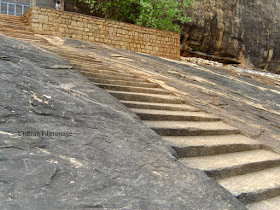Kannagi's wrath made the ancient city of Madurai go up in flames and after causing destruction she marched towards Kerala. She is believed to be an incarnation of Goddess Parvati and she is the heroine of Silappadikkaram, an epic penned by Jain poet Ilango Adigal ; Her destination was Kodungallur ( Yet another seat of Goddess , shall post soon) and en route she halted for a brief moment in Attukal , thus bringing her divine presence to an obscure place which has become a great pilgrimage centre, especially for women as this is known as Sabarimala of women.
This temple is a just 2-3 Kms from Sri Anantha Padmanabha Swamy temple . The Goddess here is very powerful , affectionate and the steady stream of pilgrims itself is a proof to show that she fulfills the wishes of her devotees.
She is also known as Attukal Amma ( Mother ) and the the Pongala festival( February-March)is famous here which draws a mammoth crowd from all over India and abroad
Pongala festival is offering the Goddess a soft sweet made of rice, split green gram and jaggery. This is cooked in earthenware pots outside the temple in traditional way. Make shift stoves made of brick and wood as fuel line the length and breadth of the area around the temple. Millions of women devotees participate in this festival and cook Pongal . Pongala which was just confined within the four walls of the temple has grown over the years and spread to nearby areas and now a days it even stretches to a radius of 4-5 kms. One can view this sea of pots through a veil of smoke if one wishes to visit the temple on that day. Women fast the whole day till they offer Pongala and worship the Goddess.
There are shrines for Shiva, Ganesha, Nagas and Navagraha around the main temple.
A temple worth visiting if anybody is planning visit to Trivandrum.
This temple is a just 2-3 Kms from Sri Anantha Padmanabha Swamy temple . The Goddess here is very powerful , affectionate and the steady stream of pilgrims itself is a proof to show that she fulfills the wishes of her devotees.
She is also known as Attukal Amma ( Mother ) and the the Pongala festival( February-March)is famous here which draws a mammoth crowd from all over India and abroad
Pongala festival is offering the Goddess a soft sweet made of rice, split green gram and jaggery. This is cooked in earthenware pots outside the temple in traditional way. Make shift stoves made of brick and wood as fuel line the length and breadth of the area around the temple. Millions of women devotees participate in this festival and cook Pongal . Pongala which was just confined within the four walls of the temple has grown over the years and spread to nearby areas and now a days it even stretches to a radius of 4-5 kms. One can view this sea of pots through a veil of smoke if one wishes to visit the temple on that day. Women fast the whole day till they offer Pongala and worship the Goddess.
There are shrines for Shiva, Ganesha, Nagas and Navagraha around the main temple.
A temple worth visiting if anybody is planning visit to Trivandrum.



































































